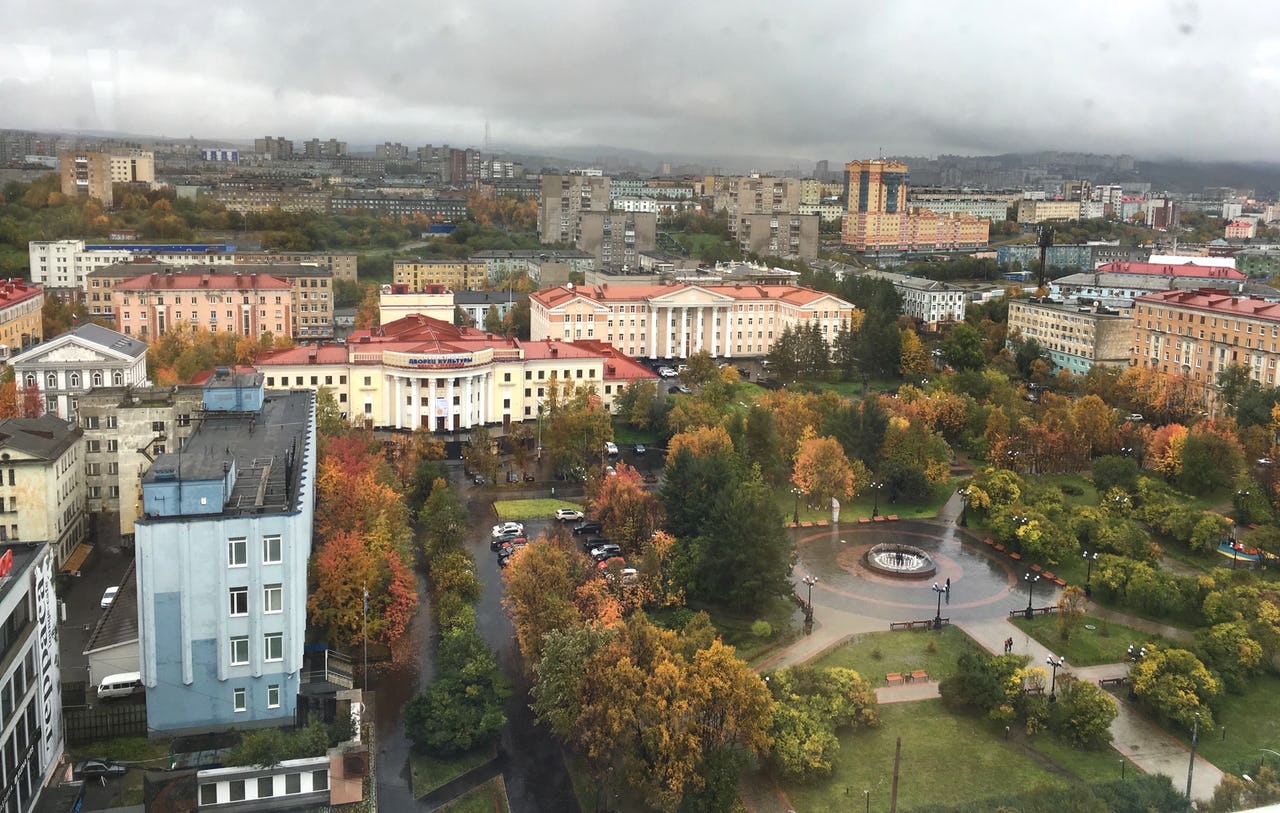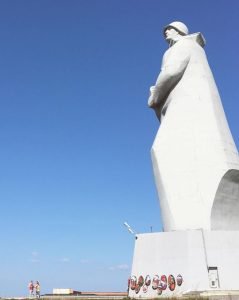A 100 years of breaking the ice in Russia’s Arctic capital

Murmansk in fall colors. View from Hotel Azimut, the tallest building above the Arctic Circle. Photo: Erika Vartdal
The Arctic is often referred to as a territory of dialogue, immune to changes in the international political environment and especially East-West tensions. But how did this happen? A place of eternal sunshine in the summer and somber darkness in the winter, Murmansk is situated on the Kola Peninsula in northwest Russia. It is by far the largest city north of the Arctic Circle, home to almost 300,000 people, several diplomatic missions, and an ice-free port situated in the heart of the Barents region.
In October 2016, Murmansk celebrated its 100th anniversary—still a young city, and still thriving. “Murman” is an older Russian term meaning “Norwegian.” This connection to Norway is still important to the residents of this Arctic hub. As a gateway to the West, paved through the High North, Murmansk holds a distinct position: the capital of an open meeting place for many actors with high expectations. This brief article showcases how this meeting place came about, and the window of opportunity it has created. A product of its history, the Barents region now has the capacity to seize opportunities in tourism, environmentalism and trade in the post-Crimean geopolitical climate. In doing so, it can strengthen the relationship with the Russian Arctic.
The hero of the North
While the city of Murmansk may only be a century old, the Kola Peninsula already had a major international port in the 16th century. Murmansk has, since its founding, faced turmoil and upswing. After supporting southern Russia in the Civil War, the city fell into despair and recession. The limited growth during the interwar years was short-lived. German aviation bombings hit the Soviet Arctic particularly hard, and left the city in ruins. The Soviet troops liberated their Norwegian neighbors in the North from Nazi occupation, establishing an exceptional, albeit controversial bond going into the Cold War. After defeating the Nazis, the restoration of Murmansk was a top priority—and, as a result, it prospered. The seaport, for example, grew to become one of the biggest in the USSR. In 1973, the Norwegian city of Vadso twinned with Murmansk, but the border was still closed and heavily militarized.1)
In 1985, Murmansk was awarded the honorary title of a “Hero-city” for outstanding heroism during the war, and the population peaked at almost half a million. It was a short-lived peak, however, since the fall of the Soviet Union led the population to decline. Just then, a new and ambitious political idea emerged: on 11 January 1993, the Declaration on cooperation in the Barents Euro-Arctic Region was signed, formally establishing the Barents region. In total, 13 counties and Indigenous communities from Northern Norway, Sweden, Finland and Russia took part in the agreement, which operates at both regional and governmental level. In the Barents-Euro Arctic Council, the chairmanship rotates every second year between the four countries, and the Foreign Ministers meet at the end of each chairmanship term. The regional council rotates between the various counties.2) The Barents cooperation encompasses a dynamic array of projects: from a focus on youth development, culture and research to environmental and economic cooperation. Only a few weeks after the declaration was signed, Norway and Finland established diplomatic missions in Murmansk. The borderland became an unlikely meeting place amid post-Cold War frictions—from closed border to closer neighbors. Now, 25 years later, the declaration is more relevant than ever.
Murmansk and the Barents region on the global stage
In the early international discourse on Arctic governance, Murmansk and the Barents region languished in the shadows. Yet, this close relationship emerged from shared interests, and the ambitions of an integrated region. For Northern Norway and Finland, the relationship to Russia has always played a key role in local governance, culture, sports, tourism, and economic growth—and vice versa. Post-Crimea, this cooperation has now found its way into the national discourse: High North and low tension. Regional cooperation with Russia is now a key foreign policy priority for both countries.
People in the Barents Region enjoy more lenient visa regulations and interact with their international neighbors on many levels. In February, border crossings between Norway and Russia increased by 18.3%3) compared to the same month in 2016, after a significant decline in crossings since 2014. The Barents region also attracts thousands of investors, politicians, students, and researchers to international conferences every year. Since 1993, the Norwegian Barents Secretariat has realized more than 4000 Norwegian-Russian cooperation projects.4) A review from the Russian side confirms that Russia’s involvement in the Barents cooperation has provided access to Nordic cooperative principles, which is seen as positive.5) Post-Crimea, this regional cooperation scheme has persisted despite growing East-West tensions. Since 2014, new agreements have been signed in the fields of health cooperation, borderland development and seismic research. Undoubtedly, the ambitious Barents project has contributed to peaceful developments in the European North.
The intricacies of the Barents relationship became evident in late 2015 with the emergence of an “Arctic refugee route.” The unexpected wave of refugees and migrants traveling through Murmansk and Nikel to apply for refugee status in Norway strained local authorities, and required delicate cooperation. By using the institutional mechanisms in place, Norwegian and Russian authorities agreed to jointly address the situation, which was in the interest of both countries. The consequence was an unprecedented attention of the region on the global stage, showing its interconnectedness with the rest of the world. Secondly, it initiated a controversial and ideological immigration debate within national borders in Norway, Finland and Russia.6) Thirdly, it revealed defects and loopholes in immigration regulations, and tested the region’s ability to handle a large influx of people. Most importantly, because it involved input from both local and national authorities, it showcased the value of establishing networks with the Russian Arctic.
Shared interests, shared partners
Moscow is highly interested in further developing the potentials of the Russian Arctic. To do so, it requires the continued support of its neighbors. In the 21st century, the Murmansk region has experienced a growth in tourism, trade and investment in infrastructure—significantly reducing the travel time from Finland and Norway. The Russian Arctic accounts for more than 20 percent of the country’s total national exports7) with an abundance of natural resources. Yet since 2014, a freeze in economic cooperation and a significant reduction in trade led industries to suffer, with negative consequences for Russia and its neighbors. However, Russia is now planning to renew its fishing fleet, and is looking to Norway for the required maritime technology.8) The Murmansk region is also part of a new development program to support eight Arctic Zones, totaling 210 billion rubles investments until 2020.9) These zones are meant to develop the potential of the Northern Sea Route and facilitate international trade.
All this shows that Russia places serious emphasis on the potentials and capacities of its Arctic regions, of which environmental protection is a priority. 2017 is the year of ecology in Russia, yet environmental challenges from the Kola Nuclear Power Plant in the borderland with Norway are still lurking. Search and rescue, oil spill response, fish stock management, and nuclear safety cooperation have been on the bilateral agenda with Norway for decades, and cited as success stories. This June, a shipment of used nuclear fuel from 100 nuclear submarine reactors in the Murmansk region is scheduled to begin. But reducing cross-border air pollution and liberalization of maritime trade are also in Norway and Finland’s interests. Combined with a desire to maintain a steady dialogue with the other part in the High North, this creates a fertile ground for cooperation – as it has in the past.

Tourism is another vastly unexploited potential; growing in both the Russian, Norwegian and Finnish Arctic. In July 2016, the ports of Murmansk and Arkhangelsk were included in the 72-hour visa-freedom regime for cruise-passengers. Visitors searching for Northern lights, untouched nature and the Arctic experience can worry less about the bureaucratic visa-jungle. In recent years, transport connections have become key priorities within the framework of the Barents cooperation. However, with long distances and few tour operators, the Barents region is not operating as a unified tourist destination. With a brand new sea pier, Murmansk is hoping to change this with Norwegian cruise-companies potentially extending their route from Kirkenes to Murmansk.10) In sum, Russia has successfully worked to develop and uphold cities, universities, communities in its North. At the same time, environmental protection generally is a large part of Russia’s Arctic strategy for 2020. For example, high investments are made to reduce air pollution from power plants.. Norway has the exact the same interests, which creates a mutual vision and thus a good basis for cooperation.
Breaking the ice in 2017
The Barents meeting place has withstood the worst post-Crimea tensions. As a result, it receives growing attention both nationally and globally. But this has also created a political debate dividing the High North and the rest. Most Norwegians south of the Arctic Circle have no relationship with neighboring Russia, and the High North feels far away. This was evident when Oslo decided to build a steel fence against the Russian border—causing disbelief with Norwegians living close to the border. Such unpopular decisions are driving people and politicians in the North to disapprove of the current foreign policies towards Russia.11) The Barents region must not settle for this divide, nor fall into the trap of complacency. We are hearing concerns about the Arctic drowning in global international conflicts such as Syria, Brexit, a weakened EU and the refugee crisis.12) Therefore, it is more important than ever that the Barents region refrains from resting on the achievements of the past. Rather, it should use its unique vantage point to advance the dialogue with Russia to the next level. Shared management of fish stocks, the 2010 maritime delimitation treaty in the Barents Sea, and people-to-people projects are milestones indeed. But they are milestones of the past.
On 29 March, Norwegian engagement in the Russian Arctic set a new milestone with the first high-level political meeting breaking the ice since 2014.13) Symbolically, Lavrov and Brende, the Foreign Ministers of Russia and Norway respectively, met for bilateral talks at a conference in Arkhangelsk called “Arctic – Territory of Dialogue.” The expectations prior to this bilateral meeting were high, and a glimpse of optimism of a closer dialogue on the national level followed. Several meetings with representatives from Russia, Norway, Finland, Sweden, Denmark, Canada and Iceland also took place. But more important is the timing of the conference: set at a time when Norway-Russia relations are at an all-time low and East-West tensions higher than in a long time. Nonetheless, the commitment to international cooperation in the Arctic region was confirmed. The conference was prestigious and of high importance to Russia: attended by 1500 participants, including President Vladimir Putin. Again, the Russian Arctic was the place of relief at a crucial time, a relief from the bigger questions that remain unanswered; the situation in Syria, Ukraine and the EU’s economic sanctions on Russia.
As these challenges surface globally, the Barents region is in a position that is rife with opportunities: in tourism, maritime industries, and environmental protection. But how can these opportunities be seized? A first step would be to communicate an understanding of this historical relationship beyond the Barents arena, and to utilize the attention the region has achieved, while continuing to fill the vacuum with dialogue and balancing of respective interests – which was illustrated at the conference in Arkhangelsk. By emphasizing and relying on established networks, these mutual interests were used as examples for why the window of dialogue must continue. Even though the Barents cooperation framework is cited as a success story, it has also become less symbolic. In recent years, it has become more of a political instrument than anyone could have foreseen when the declaration was signed in 1993. Perhaps such a political role was unavoidable post-Crimea, but the region has proved capable of taking on this role. Certainly, it can be a model for communities across the circumpolar world; a model of an unlikely friendship pacing forward in the most challenging of times.
History as the case for engagement
Murmansk holds a vital role in the development of the Russian Arctic and the Barents region. This is attributed not only to its shared history, but also to its social and political proximity with communities who view cooperation as the ultimate key to success in the High North. Through steady, predictable, and close engagement with the Russian Arctic, the multilateral Barents cooperation venture can rightly be characterized as a success story. It established an open meeting place, which has become the recipient of growing attention and national responsibility.

A century after its founding, Murmansk has become a lively society where curious visitors come for a different experience. On the horizon, they will see the 34-meter tall Aloysha soldier overlooking Murmansk. With a machine gun slung over his shoulder, the soldier is looking west, towards the Valley of Glory. This is where the Nazis were defeated after fierce fighting, and this memory still holds value to the people of Murmansk, and represents a sense of identity.
The city still rests on its past, so where will it go in the future? Amid nostalgia from the Soviet era and the memories of the Great Patriotic War, visitors will find a surprisingly modern and developed city with strong universities, top-notch facilities, accessible wildlife and good infrastructure. Murmansk will continue to be the Arctic capital of Russia, with a historic window towards Europe, closely linked to the expectations delegated from Moscow. For its neighbors, engaging with Murmansk has been challenging, but it has borne fruit for all partners. Developing this territory of dialogue requires continued engagement combined with the desire to continue cooperating with Russia as the essential foundation. This foundation is still strong, and holds the prospect for softening East-West tensions. Through its position in the post-Crimean geopolitical climate, the Barents region is equipped to yield more returns. With a past based on dialogue and reciprocity, the region has the potential to claim a bigger stake in the advancement of Arctic affairs. It can use its achievements to continue breaking the ice, to reconcile with its neighbor in the East, and with its own people.
References